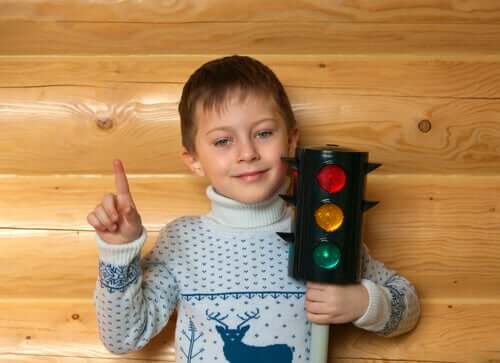The anger signal is a tool for children, usually between the age of 4 and 10, that is used to help them manage their emotions; Children of this age already identify basic emotions, but have difficulty regulating them properly.
The tricolor fire of anger is to apply the traditional tricolor fire operation to teach the child how to manage their emotions, especially negative ones.
- It should be noted that children fully understand the functioning of tricolor lights usually found on the streets.
- Hence the use of the analogy of tricolor lights and their colors.
Red indicates that we can’t pass and that we have to stop, yellow indicates that we have to wait and green means we can continue.
If we use the colors of the traffic light and what they represent in the context of a tantrum, children can learn to handle their emotions as if it were a game.
In this sense, the following question may arise: how do we get the child to learn how to connect the traffic light with his emotional answers?
To apply the tricolor fire of anger, children need to associate the colors of tricolor fire with their emotions and behavior, in this article we explain what the function of each color is and its response.
“Self-awareness implies a deep understanding of your feelings, strengths, weaknesses, needs, and impulses. “Daniel Goleman.
Why is it so important for children to regulate their emotions?Laura Chica, psychologist and coach, stresses the need to teach children emotional control and promote self-awareness of their own emotions and how to respond to them.
They also need to learn that their reactions may vary depending on their mood, so that they can choose the right answer to each situation.
Children’s psychologist Angela Cuervo highlights the importance of emotional self-regulation in children in her doctoral thesis on sadness, depression and self-regulation strategies in children.
Therefore, we highlight the use of this technique to teach them to control their emotions through the colors of the traffic light.
A team from the Department of Psychology and Neuroscience at Duke University in the United States emphasizes the importance of self-control and emotional self-regulation in the evolutionary development of people, since, according to the statistics presented in the study, the lack of this ability. it can lead to health problems in the future.
It is therefore essential to teach children to regulate their own emotions and responses.
PARE, calm down. When we can’t control an emotion, especially irritation and anger, we have to stop when we stop at a traffic light when we see the red light.
If anger drives us, it’s time to stop, to ponder what’s happening to us.
THINK about the problem and how it feels: “How do I feel now?”, “Am I angry?”, “Do I feel sad?”
Then invite the child to think about the possible alternatives and their consequences in this situation What is the most appropriate answer for me, what is the solution that brings me the most benefits?
DO, solve the problem. Once the response alternatives have been discussed, choose the option that works best for you and run it to resolve the situation you are in.
To increase a child’s positive response, it’s important to reinforce each positive behavior a child performs; Following Skinner’s theory of strengthening learning, positive strengthening makes the child feel that his effort is valued and perceived, and encourages the child to continue to maintain these behaviors.
In short, as we have indicated in this article, it is essential that children’s education takes into account the self-regulation of emotions, their way of dealing with emotions such as anger, fear, frustration.
Given the importance of acquiring this skill, we highlight the tricolor fire of anger, a simple, useful and practical tool to encourage our children to learn how to manage their own emotions.

